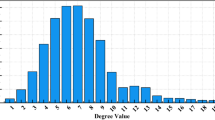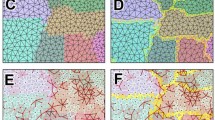Abstract
This paper proposes a system to model the spread of COVID-19. This system will work in post lockdown conditions, when the only mode of travel, is by road. It defines impact measures, that state the severity of potential disease spread, in a specific area. These impact measures are calculated based on existing hotspots, and are clustered into regions of varying danger-levels, using a graph clustering algorithm. Using this method, it can be predicted where more lenient measures may be taken, and which areas are less prone to the virus spread. There exist other methodologies to model the spread of viruses, but most overlook the spatial nature of viruses. The proposed system focuses on this limitation. Specifically, it focuses on preventing the virus spread, from a geographical point of view. Since the virus spread depends entirely on contact, regions near existing hotspots may potentially become new hotspots. The entire country is first visualized as a weighted graph of regions, at an appropriate administrative level, such as districts. The weights of the nodes are the number of active cases, and the weights of the edges are the geographical distances between those nodes. This graph is connected based on a distance threshold. The impact measure tells the impact of a region, on nearby regions, and the danger value tells the transmission possibility, between separate regions. Using this data, potential hotspots are easily identified. This data will help administrative bodies, to make more fine-tuned lockdown restrictions, based on the impact measures.
Access this chapter
Tax calculation will be finalised at checkout
Purchases are for personal use only
Similar content being viewed by others
References
J. Shibo et al., A distinct name is needed for the new coronavirus. Lancet (London, England) 395(10228), 949 (2020)
E. Mahase, Covid-19: WHO declares pandemic because of "alarming levels" of spread, severity, and inaction. BMJ (Clin. Res. ed.) 368, m1036 (2020)
Z. Peng et al., A pneumonia outbreak associated with a new coronavirus of probable bat origin. Nature 579(7798), 270–273 (2020)
Johns Hopkins University. COVID-19 Dashboard by the Center for Systems Science and Engineering (CSSE) at Johns Hopkins University (JHU) (2020)
F. Shuo et al., Rational use of face masks in the COVID-19 pandemic. Lancet Respir. Med. 8(5), 434–436 (2020)
M. Lipsitch, D.L. Swerdlow, L. Finelli, Defining the epidemiology of Covid-19–studies needed. New Engl. J. Med. 382(13), 1194–1196 (2020)
S.A. Lauer et al., The incubation period of coronavirus disease 2019 (COVID-19) from publicly reported confirmed cases: estimation and application. Ann. Internal Med. 172(9), 577–582 (2020)
Z. Fei, T. Yu, R. Du, G. Fan, Y. Liu, Z. Liu, J. Xiang et al., Clinical course and risk factors for mortality of adult inpatients with COVID-19 in Wuhan, China: a retrospective cohort study. Lancet 395(10229), 1054–1062 (2020)
S.P. Adhikari et al., Epidemiology, causes, clinical manifestation and diagnosis, prevention and control of coronavirus disease (COVID-19) during the early outbreak period: a scoping review. Infect. Dis. Poverty 9(1), 1–12 (2020)
L. Hien et al., The positive impact of lockdown in Wuhan on containing the COVID-19 outbreak in China. J. Travel Med. 27(3), taaa037 (2020)
F. E. Alvarez, D. Argente, F. Lippi, A simple planning problem for covid-19 lockdown. No. w26981. National Bureau of Economic Research (2020)
S.R. Baker, et al., Covid-induced economic uncertainty. No. w26983. National Bureau of Economic Research (2020)
Z. Yang et al., Modified SEIR and AI prediction of the epidemics trend of COVID-19 in China under public health interventions. J. Thoracic Dis. 12(3), 165 (2020)
C.O. Stallybrass, The Principles of Epidemiology and the Process of Infection (Macmillan Co., New York, 1931)
P. Elliot et al., Spatial Epidemiology: Methods and Applications (Oxford University: Oxford University Press, Oxford, 2000)
R.S. Ostfeld, G.E. Glass, F. Keesing, Spatial epidemiology: an emerging (or re-emerging) discipline. Trends Ecol. Evol. 20(6), 328–336 (2005)
R.S. Kirby, E. Delmelle, J.M. Eberth, Advances in spatial epidemiology and geographic information systems. Ann. Epidemiol 27(1), 1–9 (2017)
L. Beale et al., Methodologic issues and approaches to spatial epidemiology. Environ. Health Perspect. 116(8), 1105–1110 (2008)
D. Kang, H. Choi, J.-H. Kim, J. Choi, Spatial epidemic dynamics of the COVID-19 outbreak in China. Int. J. Infect. Dis. 94, 96–102 (2020)
R. Zheng, Y. Xu, W. Wang, G. Ning, Y. Bi, Spatial transmission of COVID-19 via public and private transportation in China. Travel Med. Infect. Dis. 34, 101626 (2020)
R. Huang, M. Liu, Y. Ding, Spatial-temporal distribution of COVID-19 in China and its prediction: a data-driven modeling analysis. J. Infect. Developing Countries 14(03), 246–253 (2020)
K.L. Cooke, P. Van Den Driessche, Analysis of an SEIRS epidemic model with two delays. J. Math. Biol. 35(2), 240–260 (1996)
S. Tuli et al., Predicting the growth and trend of COVID-19 pandemic using machine learning and cloud computing. Internet Things 11, 100222 (2020)
S. Zhao et al., Preliminary estimation of the basic reproduction number of novel coronavirus (2019-nCoV) in China, from 2019 to 2020: A data-driven analysis in the early phase of the outbreak. Int. J. Infect. Dis. 92, 214–217 (2020)
V. Zarikas et al., Clustering analysis of countries using the COVID-19 cases dataset. Data Brief 31, 105787 (2020)
B.S. Pujari, S.M. Shekatkar, Multi-city modeling of epidemics using spatial networks: Application to 2019-nCov (COVID-19) coronavirus in India. Medrxiv (2020)
B. Murugesan et al., Distribution and trend analysis of COVID-19 in India: geospatial approach. J. Geogr. Stud. 4(1), 1–9 (2020)
S. Roy, G.S. Bhunia, P.K. Shit, Spatial prediction of COVID-19 epidemic using ARIMA techniques in India. Model. Earth Syst. Environ. 1–7 (2020)
M. Liu, R. Thomadsen, S. Yao, Forecasting the spread of COVID-19 under different reopening strategies. medRxiv (2020)
B. Rader et al., Crowding and the shape of COVID-19 epidemics. Nat. Med. 26, 1–6 (2020)
S. Hisada et al., Surveillance of early stage COVID-19 clusters using search query logs and mobile device-based location information. Sci. Rep. 10(1), 1–8 (2020)
S.I. Hay, R.W. Snow, The malaria atlas project: developing global maps of malaria risk. PLoS Med 3(12), e473 (2006)
J.P. Messina et al., A global compendium of human dengue virus occurrence. Sci. Data 1(1), 1–6 (2014)
D.M. Pigott et al., Global database of leishmaniasis occurrence locations, 1960–2012. Sci. Data 1(1), 1–7 (2014)
A. Mylne et al., Comprehensive database of the geographic spread of past human Ebola outbreaks. Sci. Data 1(1), 1–10 (2014)
B. Xu et al., Epidemiological data from the COVID-19 outbreak, real-time case information. Sci. Data 7(1), 1–6 (2020)
E. Dong, D. Hongru, L. Gardner, An interactive web-based dashboard to track COVID-19 in real time. Lancet Infect. Dis. 20(5), 533–534 (2020)
L.L. Wang, K. Lo, Y. Chandrasekhar, R. Reas, J. Yang, D. Eide, K. Funk et al., CORD-19: the Covid-19 open research dataset (2020). arXiv-2004
E. Chen, K. Lerman, E. Ferrara, Covid-19: The first public coronavirus twitter dataset. arXiv preprint arXiv:2003.07372 (2020)
COVID-19 India Org Data Operations Group, covid19india.org: Coronavirus Outbreak in India, Coronavirus Outbreak in India - covid19india.org (2020). https://covid19india.org/
A.K. Jain, Data clustering: 50 years beyond K-means. Patt. Recogn. Lett 31(8), 651–666 (2010)
S. Wang, X. Zhao, Y. Chen, Z. Li, K. Zhang, J. Xia, Negative influence minimizing by blocking nodes in social networks, in Proceedings of the 17th AAAI Conference on Late-Breaking Developments in the Field of Artificial Intelligence (AAAI Press, 2013), pp. 134–136
L. Fei, Q. Zhang, Y. Deng, Identifying influential nodes in complex networks based on the inverse-square law. Physica A Stat. Mech. Appl. 512, 1044–1059 (2018)
Author information
Authors and Affiliations
Corresponding author
Editor information
Editors and Affiliations
Rights and permissions
Copyright information
© 2022 The Author(s), under exclusive license to Springer Nature Switzerland AG
About this chapter
Cite this chapter
Behera, V.N.J., Ranjan, A., Reza, M. (2022). Graph-Based Clustering Algorithm for Social Community Transmission Control of COVID-19 During Lockdown. In: Nayak, J., Naik, B., Abraham, A. (eds) Understanding COVID-19: The Role of Computational Intelligence. Studies in Computational Intelligence, vol 963. Springer, Cham. https://doi.org/10.1007/978-3-030-74761-9_6
Download citation
DOI: https://doi.org/10.1007/978-3-030-74761-9_6
Published:
Publisher Name: Springer, Cham
Print ISBN: 978-3-030-74760-2
Online ISBN: 978-3-030-74761-9
eBook Packages: Intelligent Technologies and RoboticsIntelligent Technologies and Robotics (R0)




